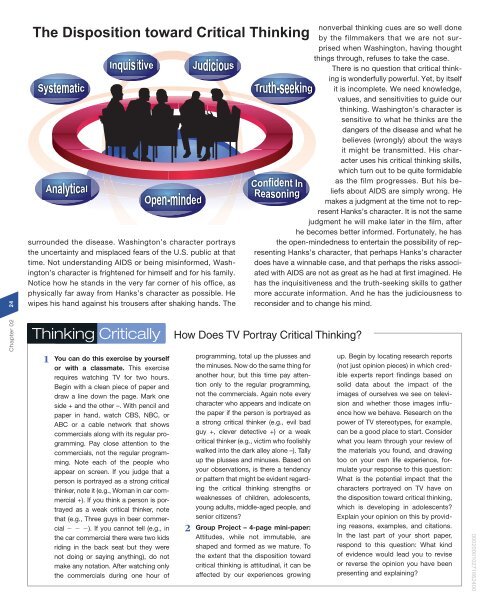Critical Thinking Disposition Self- Rating Form. - Pearson Learning ...
Critical Thinking Disposition Self- Rating Form. - Pearson Learning ...
Critical Thinking Disposition Self- Rating Form. - Pearson Learning ...
Create successful ePaper yourself
Turn your PDF publications into a flip-book with our unique Google optimized e-Paper software.
Chapter 02 24<br />
nonverbal thinking cues are so well done<br />
The <strong>Disposition</strong> toward <strong>Critical</strong> <strong>Thinking</strong><br />
by the filmmakers that we are not surprised<br />
when Washington, having thought<br />
things through, refuses to take the case.<br />
There is no question that critical thinking<br />
is wonderfully powerful. Yet, by itself<br />
it is incomplete. We need knowledge,<br />
values, and sensitivities to guide our<br />
thinking. Washington’s character is<br />
sensitive to what he thinks are the<br />
dangers of the disease and what he<br />
believes (wrongly) about the ways<br />
it might be transmitted. His character<br />
uses his critical thinking skills,<br />
which turn out to be quite formidable<br />
as the film progresses. But his beliefs<br />
about AIDS are simply wrong. He<br />
makes a judgment at the time not to represent<br />
Hanks’s character. It is not the same<br />
judgment he will make later in the film, after<br />
he becomes better informed. Fortunately, he has<br />
the open-mindedness to entertain the possibility of representing<br />
Hanks’s character, that perhaps Hanks’s character<br />
does have a winnable case, and that perhaps the risks associated<br />
with AIDS are not as great as he had at first imagined. He<br />
has the inquisitiveness and the truth-seeking skills to gather<br />
more accurate information. And he has the judiciousness to<br />
reconsider and to change his mind.<br />
surrounded the disease. Washington’s character portrays<br />
the uncertainty and misplaced fears of the U.S. public at that<br />
time. Not understanding AIDS or being misinformed, Washington’s<br />
character is frightened for himself and for his family.<br />
Notice how he stands in the very far corner of his office, as<br />
physically far away from Hanks’s character as possible. He<br />
wipes his hand against his trousers after shaking hands. The<br />
<strong>Thinking</strong> <strong>Critical</strong>ly<br />
1 You can do this exercise by yourself<br />
or with a classmate. This exercise<br />
requires watching TV for two hours.<br />
Begin with a clean piece of paper and<br />
draw a line down the page. Mark one<br />
side + and the other –. With pencil and<br />
paper in hand, watch CBS, NBC, or<br />
ABC or a cable network that shows<br />
commercials along with its regular programming.<br />
Pay close attention to the<br />
commercials, not the regular programming.<br />
Note each of the people who<br />
appear on screen. If you judge that a<br />
person is portrayed as a strong critical<br />
thinker, note it (e.g., Woman in car commercial<br />
+). If you think a person is portrayed<br />
as a weak critical thinker, note<br />
that (e.g., Three guys in beer commercial<br />
2 2 2). If you cannot tell (e.g., in<br />
the car commercial there were two kids<br />
riding in the back seat but they were<br />
not doing or saying anything), do not<br />
make any notation. After watching only<br />
the commercials during one hour of<br />
How Does TV Portray <strong>Critical</strong> <strong>Thinking</strong><br />
programming, total up the plusses and<br />
the minuses. Now do the same thing for<br />
another hour, but this time pay attention<br />
only to the regular programming,<br />
not the commercials. Again note every<br />
character who appears and indicate on<br />
the paper if the person is portrayed as<br />
a strong critical thinker (e.g., evil bad<br />
guy +, clever detective +) or a weak<br />
critical thinker (e.g., victim who foolishly<br />
walked into the dark alley alone –). Tally<br />
up the plusses and minuses. Based on<br />
your observations, is there a tendency<br />
or pattern that might be evident regarding<br />
the critical thinking strengths or<br />
weaknesses of children, adolescents,<br />
young adults, middle-aged people, and<br />
senior citizens<br />
2 Group Project – 4-page mini-paper:<br />
Attitudes, while not immutable, are<br />
shaped and formed as we mature. To<br />
the extent that the disposition toward<br />
critical thinking is attitudinal, it can be<br />
affected by our experiences growing<br />
up. Begin by locating research reports<br />
(not just opinion pieces) in which credible<br />
experts report findings based on<br />
solid data about the impact of the<br />
images of ourselves we see on television<br />
and whether those images influence<br />
how we behave. Research on the<br />
power of TV stereotypes, for example,<br />
can be a good place to start. Consider<br />
what you learn through your review of<br />
the materials you found, and drawing<br />
too on your own life experience, formulate<br />
your response to this question:<br />
What is the potential impact that the<br />
characters portrayed on TV have on<br />
the disposition toward critical thinking,<br />
which is developing in adolescents<br />
Explain your opinion on this by providing<br />
reasons, examples, and citations.<br />
In the last part of your short paper,<br />
respond to this question: What kind<br />
of evidence would lead you to revise<br />
or reverse the opinion you have been<br />
presenting and explaining<br />
000200010271662400<br />
Think <strong>Critical</strong>ly, by Peter Facione and Carol Ann Gittens. Published by Prentice Hall. Copyright © 2013 by <strong>Pearson</strong> Education, Inc.

















